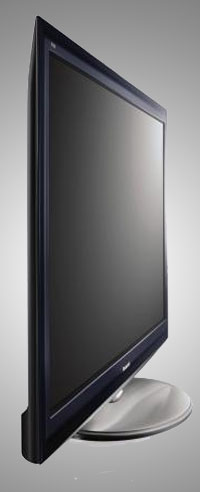Test Report: Panasonic TC-L42d2 LCD HDTV Page 2
 SETUP
SETUP
After you pick the home mode (presumably) during initial setup of the TC-L42D2, its settings auto- adjust for a more civil picture, a far cry from the automatic "torch mode" of TVs past. Each picture preset is adjustable, though Cinema gets the image closest to correct. The backlight control in Cinema is set at 30, which is plenty bright for most situations. Dialing it up to 100 will empty a room. One of the first things you should adjust is HD Size, a setting that's buried deep inside the Picture menu. Switching HD Size to 2 eliminates all picture overscan. Otherwise, the set zooms in on the image and you lose some picture area (about 5%, according to the onscreen tool tip).
All 120- and 240-Hz LCDs have a feature called motion interpolation. In order to get regular 60-Hz video to display on 120- and 240-Hz TVs, the set has to create new frames. These can just be duplicates of the original frames, or the TV can create new frames that interpolate whatever motion would have happened between each original frame. Panasonic calls this type of processing 120Hz Motion Picture Pro 4. There are two modes, Weak and Strong. If you're watching film-based content (most TV shows and nearly all movies), Strong creates an image that is almost unnaturally smooth. It makes everything look like it was shot on a Handicam. (Personally, I hate it.) In Weak mode, the processing is just barely perceptible but still there. With sports and other programs originating on video, on the other hand, this unnaturalness isn't present.
I left 120Hz Motion Picture Pro 4 switched off for all movies and most TV watching. (If you supply the TC-L42D2 with a 24p source - from Blu-ray, for ex- ample - it will multiply these frames without any other processing in Off mode, resulting in a judder- free image that looks much better than 24p material displayed on a 60-Hz TV.) The downside to leaving it off is that the anti-motion-blur advantages of the process disappear. (More on this later.)
One thing that will be noticeable by its absence is the Viera Cast media-streaming portal, which many other new Panasonic products have. Internet media streaming has become insanely popular, and in addition to Netflix, Viera Cast offers Amazon Video on Demand and now Vudu (Blu-ray only). Seeing as cheaper Panasonic TVs and even Blu-ray players have this feature, its lack here is notable. Instead, the TC-L42D2 comes with an external iPod dock. This small dock is plastic but reasonably hefty. The menus for content navigation aren't exactly pretty, but they get the job done. The iPod charges while in it, and performance is pretty good: SD-quality programs from iTunes displayable on an iPhone/touch look surprisingly decent on the TC-L42D2 - not too much worse than DVD.













































